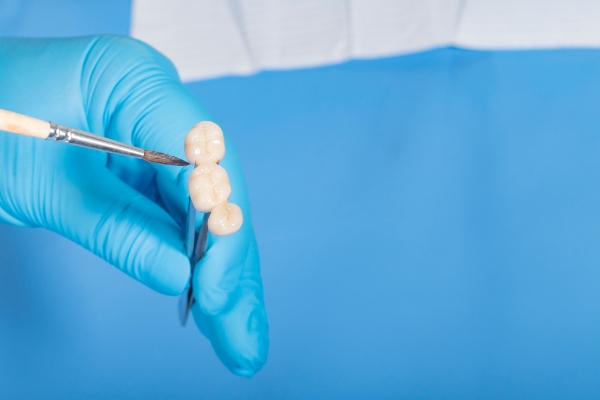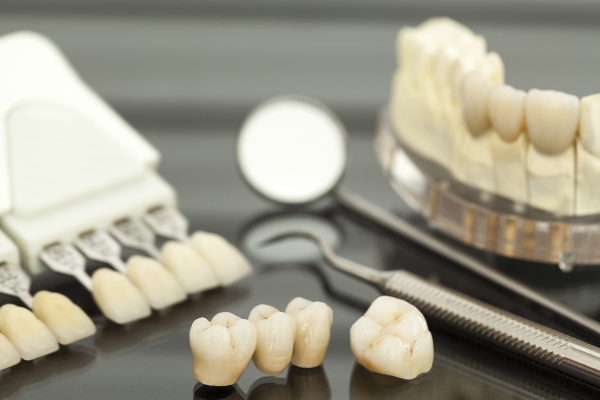Pros and Cons of Dental Bridges

For those who have experienced tooth loss or irreparable damage to a tooth, dental bridges can help. This type of treatment replaces missing teeth by anchoring a prosthetic alternative to the two adjacent teeth, bridging the gap between them — hence the name. Bridges can be used to replace up to four adjacent teeth, depending on the individual.
Is this treatment option right for you? Like any other type of dental work, there are benefits and drawbacks to receiving dental bridges that should be carefully considered. A dentist can also offer insight that may apply to your unique situation.
The pros of a dental bridge
Bridges have been used by dentists for decades. They are an effective method for treating tooth loss that offers many advantages to patients.
Improves cosmetic appearance
One of the main reasons most people seek treatment for tooth loss is to improve their appearance. Severely damaged or missing teeth can create unattractive gaps in your smile that are very noticeable to others. Bridges are prosthetics, but they are designed to match the shape, size, and color of your natural teeth, enhancing the look of your smile.
Protects surrounding teeth from damage
Even though replacing a missing tooth has cosmetic benefits, it is also necessary to protect your oral health. When a tooth is lost, the surrounding teeth have to make up for it by withstanding excess pressure and force. Over time, this can lead to damage that may cause cracks and chips, increasing the risks for decay and requiring more repairs. A bridge replaces the missing tooth and is made from durable materials so it can withstand the pressures of everyday biting and chewing, protecting the other teeth from unnecessary damage.
Prevents pain, speech, and digestive issues
Missing teeth can make it difficult to chew your food properly. As a result, you may favor one side or area while eating but still have problems chewing thoroughly. This can lead to digestive troubles over time, as well as tooth and jaw pain. Restoring your smile with dental bridges ensures proper, comfortable chewing and a more even bite. In addition, replacing lost teeth helps prevent speech issues from developing.
Offers fast results
Many patients can have a bridge placed in as little as one dental visit. This quick turnaround helps prevent complications from developing before treatment is complete. The recovery process is also speedy with most patients resuming normal activities in a day or two.
Requires minimally invasive dental work
Other options for tooth replacement, such as traditional dental implants, require multiple surgeries and months of recovery. The process can be difficult for those who do not tolerate dental work well. Dental bridges do not require surgery or incisions, so they may be preferable to those who want a less invasive treatment option.
The cons of a dental bridge
Though dental bridges are often recommended by dentists and are both safe and effective, some disadvantages come with choosing this type of treatment for tooth loss. In addition to adjusting to the feel of a bridge, patients should be aware of these other issues.
Has a limited life span
With good home care and routine professional cleanings, a bridge can last for more than a decade. Most people should expect to get five to seven years out of a dental bridge before needing a replacement. While it is a sturdy solution to tooth loss, it is not a permanent one.
Requires specific care for cleaning
Bridges fit tightly against the surrounding teeth and gums, but food particles and bacteria can still become trapped here. In addition to careful brushing twice a day, patients need some other tools to clean a bridge well, such as:
- A water flosser
- An interdental brush
- Floss threaders
A dentist will instruct you on how to use these tools for proper cleaning.
May not prevent bone loss
Dental bridges do not extend below the gum line, so they cannot stimulate the bone underneath. While they do allow you to use the general area more when chewing, they are not effective at preventing bone loss under the specific teeth that were lost.
Produces less natural results
A bridge is more appealing than a missing tooth to most people, but it does not provide the same realistic results that other options can offer. Upon close-up inspection, it may be noticeable to others. However, most people will not be able to tell that you have a dental bridge.
Conclusion
There are many pros and cons to choosing dental bridges. Talk with your dentist to determine if this option is a good choice for your dental health.
Request an appointment here: https://www.grandvalleydentistry.com or call Grand Valley Dentistry at (616) 259-6046 for an appointment in our Allendale Charter Twp office.
Check out what others are saying about our dental services on Yelp: Dental Bridges in Allendale Charter Twp, MI.
Recent Posts
Replacing missing teeth preserves the look and function of the smile, and a dental bridge is one of the most versatile ways to do that. Dental bridges are a popular tooth replacement method for numerous reasons. Here is a closer look at the benefits of this restoration and the process for getting one.A dental bridge…
A dental bridge is not a permanent restoration despite the changes that the neighboring natural teeth will go through for the treatment. However, there are different types available, each one capable of meeting your dental needs. Your dentist can present both permanent and removable options. Here are the details on the impermanence of a dental…
Single-tooth replacement is important for oral health and the appearance of the smile. The dental bridge is one of the most popular options for individual tooth replacement. Here is a closer look at why single-tooth replacement is crucial and the advantages of a dental bridge.Having just one missing tooth visible when smiling can make someone…
A dental bridge is a popular tooth replacement option for those missing one or several teeth. Missing teeth can cause problems that go beyond the aesthetic. Therefore, patients should replace teeth promptly to preserve the health and appearance of their smile. Fortunately, a dental bridge is an effective and natural-looking way to do that.A dental…


